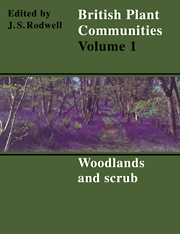Book contents
- Frontmatter
- Contents
- List of Figures
- Foreword
- Preface and Acknowledgements
- Preamble
- General Introduction
- Woodlands and Scrub
- Introduction to Woodlands and Scrub
- Key To Woodlands and Scrub
- Community Descriptions
- W1 Salix Cinerea-Galium Palustre woodland
- W2 Salix Cinerea-Betula Pubescens-Phragmites Australis Woodland
- W3 Salix Pentandra-Carex Rostrata Woodland
- W4 Betula Pubescens-Molinia Caerulea Woodland
- W5 Alnus Glutinosa-Carex Paniculata Woodland
- W6 Alnus Glutinosa-Urtica Jzozca Woodland
- W7 Ainus Glutinosa-Fraxinus Excelsior-Lysimachia Nemorum Woodland
- W8 Fraxinus Excelsior-Acer Campestre-Mercurialis Perennis Woodland
- W9 Fraxinus Excelsior-Sorbus Aucuparia-Mercurialis Perennis Woodland
- W10 Quereus Robur-Pteridium Aquilinum-Rubus Fruticosus Woodland
- W11 Quereus Petraea-Betula Pubescens-Oxalis Acetosella Woodland
- W12 Fagus Sylvatica-Mercurialis Perennis Woodland
- W13 Taxus Baccata Woodland
- W14 Fagus Sylvatica-Rubus Fruticosus Woodland
- W15 Fagus Sylvatica-Deschampsia Flexuosa Woodland
- W16 Quereus spp.-Betula spp.-Deschampsia Flexuosa Woodland
- W17 Quereus Petraea-Betula Pubescens-Dicranum Majus Woodland
- W18 Pinus Sylvestris-Hylocomium Splendens Woodland
- W19 Juniperus Communis Ssp. Communis-Oxalis Acetosella Woodland
- W20 Salix Lapponum-Luzula Sylvatica Scrub
- W21 Crataegus monogyna-Hedera helix scrub
- W22 Prunus Spinosa-Rubus Fruticosus Scrub
- W23 Ulex Europaeus-Rubus Fruticosus Scrub
- W24 Rubus Fruticosus-Holcus Lanatus Underscrub
- W25 Pteridium Aquilinum-Rubus Fruticosus Underscrub
- Index of Synonyms to Woodlands and Scrub
- Index of Species in Woodlands and Scrub
- Bibliography
W3 - Salix Pentandra-Carex Rostrata Woodland
Published online by Cambridge University Press: 04 July 2020
- Frontmatter
- Contents
- List of Figures
- Foreword
- Preface and Acknowledgements
- Preamble
- General Introduction
- Woodlands and Scrub
- Introduction to Woodlands and Scrub
- Key To Woodlands and Scrub
- Community Descriptions
- W1 Salix Cinerea-Galium Palustre woodland
- W2 Salix Cinerea-Betula Pubescens-Phragmites Australis Woodland
- W3 Salix Pentandra-Carex Rostrata Woodland
- W4 Betula Pubescens-Molinia Caerulea Woodland
- W5 Alnus Glutinosa-Carex Paniculata Woodland
- W6 Alnus Glutinosa-Urtica Jzozca Woodland
- W7 Ainus Glutinosa-Fraxinus Excelsior-Lysimachia Nemorum Woodland
- W8 Fraxinus Excelsior-Acer Campestre-Mercurialis Perennis Woodland
- W9 Fraxinus Excelsior-Sorbus Aucuparia-Mercurialis Perennis Woodland
- W10 Quereus Robur-Pteridium Aquilinum-Rubus Fruticosus Woodland
- W11 Quereus Petraea-Betula Pubescens-Oxalis Acetosella Woodland
- W12 Fagus Sylvatica-Mercurialis Perennis Woodland
- W13 Taxus Baccata Woodland
- W14 Fagus Sylvatica-Rubus Fruticosus Woodland
- W15 Fagus Sylvatica-Deschampsia Flexuosa Woodland
- W16 Quereus spp.-Betula spp.-Deschampsia Flexuosa Woodland
- W17 Quereus Petraea-Betula Pubescens-Dicranum Majus Woodland
- W18 Pinus Sylvestris-Hylocomium Splendens Woodland
- W19 Juniperus Communis Ssp. Communis-Oxalis Acetosella Woodland
- W20 Salix Lapponum-Luzula Sylvatica Scrub
- W21 Crataegus monogyna-Hedera helix scrub
- W22 Prunus Spinosa-Rubus Fruticosus Scrub
- W23 Ulex Europaeus-Rubus Fruticosus Scrub
- W24 Rubus Fruticosus-Holcus Lanatus Underscrub
- W25 Pteridium Aquilinum-Rubus Fruticosus Underscrub
- Index of Synonyms to Woodlands and Scrub
- Index of Species in Woodlands and Scrub
- Bibliography
Summary
Synonymy
Alder wood Rankin 1911 b; Open carr Pearsall 1918; Closed carr Pearsall 1918 p.p.; Salix carr Ingram et al. 1959; Fen carr Proctor 1974; Willow carr Adam et al. 1975 p.p.; Crepido-Salicetum pentandr ae Wheeler 1980c; Sphagno-Salicetum atrocinereae Birse 1984 p.p.
Constant species
Salix cinerea, S. pentandra, Angelica sylvestris, Cardamine pratensis, Carex rostrata, Caltha palustris, Filipendula ulmaria, Galium palustre, Geum rivale, Valeriana dioica, Calliergon cuspidatum, Mnium hornum, Rhizomnium punctatum.
Rare species
Salix nigricans, Carex appropinquata, Carex diandra, Corallorhiza trifida, Lysimachia thyrsiflora, Pyrola rotundifolia.
Physiognomy
The Salix pentandra-Carex rostrata woodland is a very distinctive woodland type, fairly constant in its overall composition and structure and with clear northern European affinities in its flora. The canopy is always low, though often uneven-topped and invariably dominated by bushy Salices, most commonly Salixpentandra and/or S. cinerea. Although the former Northern Montane willow can be found occasionally in other kinds of wet woodland in northern Britain, only in this community does it make more than a local contribution to the canopy. When it is abundant here, its typical spreading habit, with branches reaching down to the ground and often re-rooting, gives stands a very characteristic appearance. Mature individuals of S. cinerea can open up with age, too, so that, even where the cover of bushes of these species is dense, the canopy can be somewhat open. Other Salices are rare, though they can be locally abundant. Most distinctive among these are two other Northern Montane species, S. nigricans and S. phyli-cifolia which, when they occur together, frequently hybridise to produce a perplexing range of intermediates (S. × tetrapla'. Meikle 1975) among which the identity of the parents can be lost (e.g. Proctor 1974, Adam et al. 1975, Lock & Rodwell 1981). S. aurita also occurs in some stands and, more rarely, the osiers S. viminalis and S’, purpurea and these, too, may hybridise among one another and with the other Salices.
The only other woody species to occur with any frequency in the community is Betula pubescens and even this is only occasional. Alnus glutinosa is rare and the associates of the canopy of southern fen woods like Frangula alnus, Rhamnus catharticus and Viburnum opulus are typically absent. Neither does an underscrub of Rubi or Ribes spp. ever play a prominent part here.
- Type
- Chapter
- Information
- British Plant Communities , pp. 65 - 71Publisher: Cambridge University PressPrint publication year: 1991

